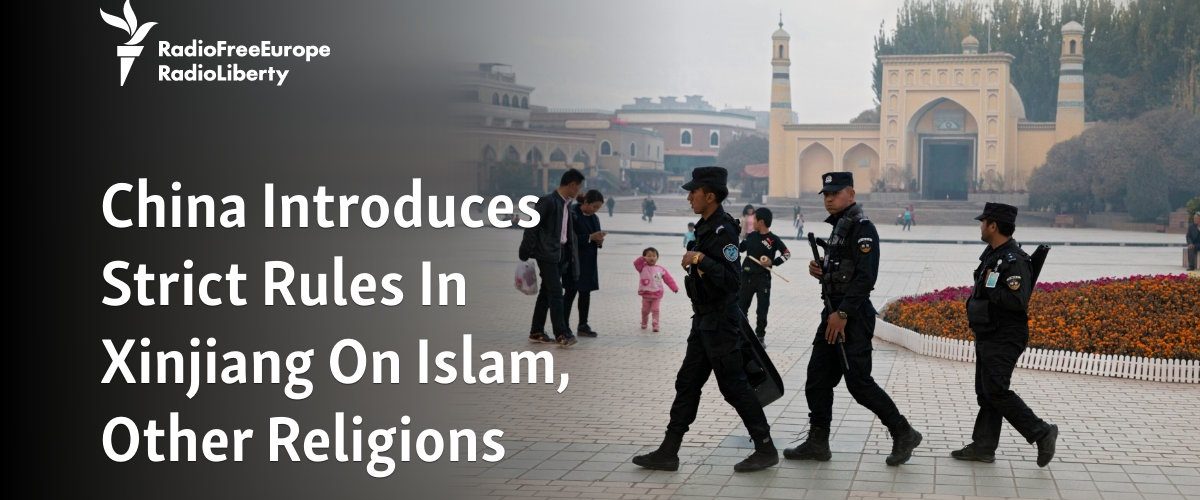In a move set to tighten government control over practicing religion in China’s western Xinjiang Province, the Muslim-majority region will introduce a set of regulations that — among other things — will require all new places of worship to reflect “Chinese characteristics and style.”
The sweeping legislation will come into force on February 1 as part of a broader multiyear campaign aimed at controlling religion in Xinjiang, which is home to mainly Muslim ethnic groups such as Uyghurs, Kazakhs, Kyrgyz, and Hui (aka Dungans).
As part of the new set of “regulations on religious affairs,” all new mosques, churches, and other religious buildings must reflect Chinese design elements and any renovations to extant layouts will require approval from Xinjiang’s regional authorities. Additional measures include controls on “large-scale” religious gatherings — which will require approval from the local government at least one month in advance — and that religious content posted online must be screened by the regional government.
The rules also say for the first time that interpretations of religious doctrine must “meet the requirements of contemporary China’s development and China’s outstanding traditional culture,” a move that experts warn could further cement an ongoing crackdown against Uyghur and minority rights in the region.
“The move is significant, as it’s about cutting off China’s religions from international networks and communities and keeping them socially and politically isolated under the watch of the Chinese Communist Party,” Bradley Jardine, managing director of the Oxus Society for Central Asian Affairs, told RFE/RL.
China has been accused of systemic human rights violations in Xinjiang, including launching a dragnet that sent more than 1 million Uyghurs, Kazakhs, and other Muslim minorities to detention camps and prisons.
A growing body of evidence — including firsthand testimony and leaked official Chinese government documents — support the accusations, which range from forced labor to sexual abuse, forced sterilization, and erasing Uyghur cultural and religious identity, including the tearing down of mosques and other religious sites.
These actions have drawn accusations of genocide from international rights groups and several Western governments. In 2022, a UN report found China was committing “serious human rights violations” in Xinjiang that may amount to crimes against humanity.
China has denied any human rights abuses in the region and says that its policies in Xinjiang are designed to counter extremism and terrorism.
Against this backdrop, local activists are worried about the lasting effects of these policies as the new rules come into force.
“Religious rights have long been restricted in Xinjiang,” Bekzat Maksutkhan, the director of Naghyz Atazhurt, an unregistered organization in Kazakhstan focused on ethnic Kazakhs affected by the crackdown in Xinjiang, told RFE/RL. “But this law is the legalization of all those previous actions.”
What Does The New Law Mean?
Since the founding of the People’s Republic of China in 1949, the communist government’s atheistic ideology has led to consistent efforts to suppress and control religion inside the country.
But while previous legislation has governed religious practices inside Xinjiang, experts say that the new legislation marks a significant escalation, demanding not just control but a specific reflection of “Chinese characteristics and style” in religious buildings and customs.
According to the regulations set out for Muslims, religion should not interfere in “clothing, weddings, funerals, and other ethnic customs” and “religious activity sites that are newly built or renovated, expanded, or rebuilt should reflect Chinese characteristics and style in terms of architecture, sculptures, paintings, and decorations.”
Claims of Chinese authorities altering or pulling down mosques in Xinjiang are not new, with a 2020 report from the Australian Strategic Policy Institute documenting the destruction and renovation of mosques in Xinjiang, finding two-thirds were changed, mostly since 2017, when Beijing accelerated its crackdown and expanded its camp system.
A 2023 report by the watchdog group Human Rights Watch used public documents, satellite images, and witness testimony to show that the Chinese government had expanded its campaign of closing and altering mosques to regions other than Xinjiang, as part of an official policy known as “consolidation.”
As part of this, local authorities have removed architectural features of mosques — such as Arabic-style domes and minarets — replacing them with traditional Chinese designs to make them look more “Chinese.”
Authorities in Beijing have rarely commented on this policy, but a June 2022 report by the Chinese state news outlet CCTV praised the removal of such architectural features as “protecting traditional heritage.”
The new regulations look to formalize and build on these policies.
Beyond the rules on mosques, the law looks to expand the authority of the Islamic Association of China, the official government supervisory organ for Islam. The state body will now be the only organization that can organize activities related to the hajj, the Muslim pilgrimage to Mecca, and only mosques and individuals that are members of the association will be allowed to participate.
The law also calls on religious leaders to transmit a “patriotic” spirit to followers and stipulates that religious schools should instill Chinese characteristics, such as praising socialism and using Mandarin Chinese, in their teachings.
“China is trying to justify its crimes in Xinjiang to the world and the international community to make their crimes appear legitimate,” Yerbol Dauletbek, the head of Atazhurt Eriktileri, another organization in Kazakhstan that helps ethnic Kazakhs, told RFE/RL. “This law is one of them.”
Why China Targets Religion
The ruling Chinese Communist Party has viewed religion as a form of foreign influence that could undermine its authority and has looked to control and suppress all major religions in the country.
China’s overall policy has been called “Sinicization,” which requires religious groups to align their doctrines, customs, and morality with Chinese culture. The government also has strict rules for all religions, with provisions in its national law saying that it is illegal for minors 18 years or younger to attend religious services or celebrations or be taught about religion in any way.
Government pressure has been particularly targeted toward religions that Beijing views as foreign, such as Islam and Christianity — both Protestantism and Catholicism.
Authorities have in the past removed crosses from churches and had others demolished.
Christianity in China is also governed by several sets of rules. Christians are allowed to worship in “official churches” registered with supervisory government agencies, although millions of Christians in China still worship in underground churches.
Since Xi Jinping became leader of the Communist Party in 2012, Beijing has tightened control over Christian activities outside of registered venues, shutting down churches that refuse to register and arresting prominent church leaders.
Buddhism — particularly Han Buddhism, the most widespread branch practiced in China — has been treated more leniently by Chinese authorities, but the government has cracked down on Buddhists in Tibet.
Beijing has tried to cement allegiances there and discourage support for the Dalai Lama, the Tibetan Buddhist leader living in exile in India. Chinese officials have also been accused of carrying out “political reeducation” campaigns, separating children from their families, and have torn down thousands of Tibetan Buddhist monasteries, monuments, and statues.
A similar approach to that practiced on Buddhism in Tibet has also been applied to Islam in Xinjiang.
When Xi last visited the region in August, he called on officials there to conserve “hard-won social stability” and to “more deeply promote the Sinicization of Islam and effectively control illegal religious activities.”
“When we say Sinicization, the broad core is aimed at cutting [these] world religions off from the world,” Jardine said. “And [instead] keeping them locally grounded, tied to the Communist Party, and politically neutralized.”



















